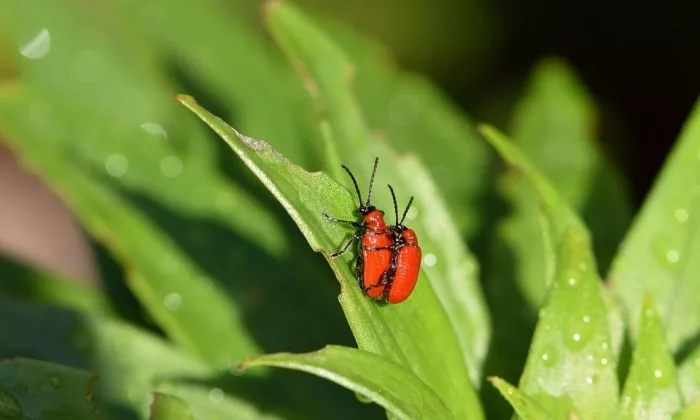A beautiful creature but sinister too: Scarlet lily beetle

You simply cannot miss this little bug. And if you do not see it in your garden just plant lilies somewhere and this little bug will arrive in no time. Scarlett lily beetle (Lilioceris lilii Scopoli) nibbles on leaves and can even completely destroy your lilies.
The first Scarlett lily beetles may appear in your garden as early as in April. You do not even need to meet them face-to-face, because the unmistakable evidence of their presence are the holes in leaves and later also in buds and flowers. They leave no part of lilies out.
You can hardly confuse this bug with anything else
It is mainly found on lilies. Its size ranges from 6 to 9 millimetres and it bright red colour is unmistakable. In case you did not know, it also has rather long claws on its legs. The underside is black and that is an important feature for this bug.
After mating, the females lay tiny eggs on the underside of leaves. They soon hatch into yellow-orange or dirty orange larvae with a black heads. Their appetite is huge, just like the appetite of their parents. Each female can lay up to 400 eggs and the larvae can start devouring your lilies as early as in May. So the sooner you act, the better.
Just collect the beetles
The defence is pretty straightforward – just collect the bugs one by one and then get rid of them. You know that you are picking bright red bugs so we should be easy, right? But there is a catch. When scarlett lily beetle feels danger </ strong>it loses its grip and falls to the ground, usually upside down – the black side up. So, there is a huge probability that you will not see them on the ground.
Try using white paper or fabric and place it on the ground. This should spoil that trick and you should be able to spot them. However, if you have many of them you will have no choice but to use chemical spraying. Further, at the end of summer, carefully remove the top layer of soil under your lilies, because that is where they are preparing to hibernate. Replace the removed layer with a new, nutritious substrate, and with a little bit of luck, the next summer you will not find any scarlet lily beetles, hopefully.
Photo: Pixabay

Gardening is my hobby, I have a lot of experience and I am happy to share it.








0 comments